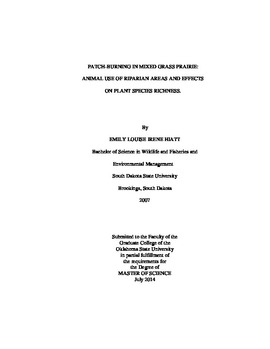| dc.contributor.advisor | Fuhlendorf, Sam | |
| dc.contributor.author | Hiatt, Emily Louise Irene | |
| dc.date.accessioned | 2015-06-17T20:06:17Z | |
| dc.date.available | 2015-06-17T20:06:17Z | |
| dc.date.issued | 2014-07-01 | |
| dc.identifier.uri | https://hdl.handle.net/11244/14881 | |
| dc.description.abstract | Riparian areas comprise a minor portion of rangelands, but are environmentally sensitive areas with potential for high biological diversity. Livestock preferentially graze riparian areas, under traditional grazing management practices. Preferential grazing of riparian areas increases livestock impact, which leads to disruptions in historical riparian function. We compared livestock area selection in traditionally grazed pastures with selection in experimental patch-burn pastures. Burns were applied in sequential rotation to a quarter of each experimental pasture every year resulting in a 4-year fire return interval. Forage quality was highest on recently burned patches attracting free-roaming livestock. Results indicate burning consistently influenced forage quality by enhancing nutrient content although all results were not significant in both years. Cattle were outfitted with a GPS collar to record their location. Selectivity indices from this study indicate cattle in traditionally managed pastures selected riparian areas at a rate approximately five times greater than livestock in pastures under patch-burn grazing management. Additionally, this study indicated that patch-burn grazing may rotate grazing pressure among riparian areas based on location of burn, thus increasing the temporal and spatial heterogeneity created by grazers' disturbance of riparian areas. Forage nutrient content was analyzed for patches that varied by year of burn. Natural disturbance regimes are critical to biological diversity. Complex interaction among disturbance processes, such as fire and grazing, promote a mosaic of plant communities that vary in structure and successional stage. Topoedaphic variability, site history, and disturbances contribute to landscape heterogeneity. Traditional grazing management that emphasizes uniform disturbance decreases heterogeneity. Variation in disturbance types and intensities may result in distinctively different post-disturbance communities. Grazing management strategies based on historical disturbances may be capable of promoting grassland biodiversity. Patch-burn grazing management mimics historical fire and grazing interactions. This study compares the results of three management treatments within the mixed grass prairie of Western Oklahoma on plant species diversity. Management treatments are 1) traditional management for the region 2) patch-burn management and 3) ungrazed, unburned management. Plant species richness did not differ between treatments. Significant differences were demonstrated by year, presumably due to differences in precipitation. | |
| dc.format | application/pdf | |
| dc.language | en_US | |
| dc.publisher | Oklahoma State University | |
| dc.rights | Copyright is held by the author who has granted the Oklahoma State University Library the non-exclusive right to share this material in its institutional repository. Contact Digital Library Services at lib-dls@okstate.edu or 405-744-9161 for the permission policy on the use, reproduction or distribution of this material. | |
| dc.title | Patch-burning in Mixed Grass Prairie: Animal Use of Riparian Areas and Effects on Plant Species Richness | |
| dc.type | text | |
| dc.contributor.committeeMember | Engle, David M. | |
| dc.contributor.committeeMember | Wilson, Gail | |
| osu.filename | Hiatt_okstate_0664M_13367.pdf | |
| osu.accesstype | Open Access | |
| dc.description.department | Natural Resources and Ecology Management | |
| dc.type.genre | Thesis | |
| dc.subject.keywords | forage quality | |
| dc.subject.keywords | patch-burn grazing | |
| dc.subject.keywords | prescribed fire | |
| dc.subject.keywords | riparian grazing | |
| dc.subject.keywords | species diversity | |
